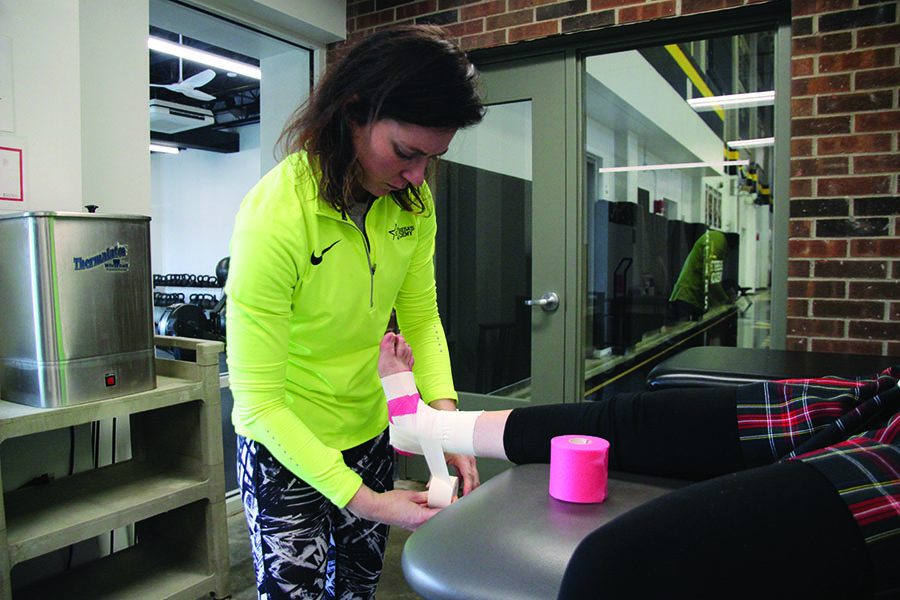The physical demands of sports can have lasting effects
The passion athletes have for their sport can result in pushing themselves too far.
February 26, 2019
Sophomore, Abbi Hennessy spends hours after school running from three to nine miles through the Kansas City area each day with her cross country team. After that she heads to her club team soccer practice to do more running and training, rounding out her athletics for the night at about nine each night in the fall. The culture of girls’ high school sports has become students’ main focus after academics. Being at a competitive level requires a large amount of rigor which can lead to several injuries on athletes’ bodies.
During the fall club soccer season, Hennessy was turning in a game to kick a ball and tore her ACL. This injury ended both her club soccer and cross country season.
“I think I was leading up to the [injury],” Hennessy said. “There was a lot of stress on my body, I was playing two sports at once.”
High school athletes put high demands on their body day after day. This calls for a staff of trainers who can watch the players closely to make sure their body is properly taken care of according to Wilson.
Former Athletic Director at University of Missouri Kansas City Carla Wilson says, “The biggest thing is realizing girls’ bodies are different than men’s. Men have more muscle mass, they are stronger, so making sure they don’t push them to levels the same as the men so we usually had different coaches for the women and the men.”
Female athletes tend to injure common parts of their body. St. Teresa’s Academy has an on-site athletic trainer Lisa Gross, to care for these injuries. According to Gross, the most common injuries seen are lower leg pain that typically originate from jumping into a sport when out of shape and hip mal alignment due to the growing teenage body.
With athletes practicing everyday, tournaments and games on the weekends, a close relationship with their coaches and trainers is essential.
“They definitely care a lot about my recovery, safety is always first with them,” Hennessy said. “They want me to take my time to get back to where I was.”
The coaches and trainers keep a close eye on the athletes and have the final say on whether they will be able to play and push through an injury.
“If the trainer says they’re out, no matter how bad the coach needs them for a big game, they’re out,” Wilson said. “They always have the final say.”
Athletes may push themselves too far due to the question of whether or not they will make it to the next level of playing a college sport.
“The amount of pressure that student athletes put on themselves especially when they’re competitive and really gleamed on, you have to watch them [hiding their injury],” Wilson said. “Also, the length of your career can cause even more damage. You have to watch that and say ‘when is it enough?’”
The safety of athletes’ bodies can often conflict with their love for the sport. Junior Molly Sexton has had two concussions from playing soccer. From one of the concussions, Sexton rushed her recovery and came back to playing too soon.
“I definitely wanted to get back because I wanted to play soccer and play with my team but that also made me realize it’s important to take care of yourself in order to play,” Sexton said. “It was hard for me to play because I wasn’t fully recovered.”
While injuries at a young age may feel temporary, they can have lasting effects on the body.
“The age for lower body joint replacements, especially knees, has been steadily becoming [more common at a] younger [age] with the normalization of sports specialization, playing sports year-round without adequate rest and athletes playing a high school sport and club sport simultaneously,” Gross said. “It can be hard to think to the future at this age, but joint replacements do not last forever; a new knee at 35 means another replacement at 65, and so on.”
In some sports, life long injuries are more prevalent. According to Sexton, in her sport, head injuries are very common, not more than the NFL with CTE but with her injuries she has begun to realize how much that can affect you later in life. She has found it is more important to take care of your body.
The help of a strong athletic team and athletes being mindful of the stress they are putting on their bodies leads to fewer injuries.
“I think we know a lot more now than we used to,” Wilson said. “There’s more [equipment] we can provide. It’s really hard to prevent it if the coach and the athlete don’t have a enough good relationship to tell them what’s going on.”
Being an athlete, taking care of your body can be a full time job. Not only do athletes have to worry about their body during the game but also before and after.
“If I had the game the next day, I would always make sure I got enough sleep and ice baths,” Sexton said. ”So I think it’s just making sure after playing a sport for a few hours you don’t just go do homework but take the steps to take care of your body.”




